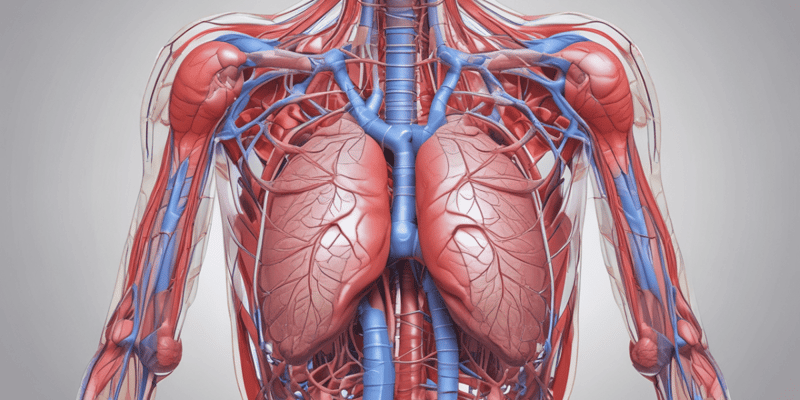Podcast
Questions and Answers
What is the main purpose of the pulmonary circulation?
What is the main purpose of the pulmonary circulation?
Which valve allows blood to flow from the right ventricle into the pulmonary trunk?
Which valve allows blood to flow from the right ventricle into the pulmonary trunk?
What is the function of the pulmonary arterioles?
What is the function of the pulmonary arterioles?
Where does gas exchange occur in the pulmonary circulation?
Where does gas exchange occur in the pulmonary circulation?
Signup and view all the answers
What is the difference between pulmonary arteries and pulmonary veins?
What is the difference between pulmonary arteries and pulmonary veins?
Signup and view all the answers
Which chamber of the heart receives oxygen-rich blood from the pulmonary veins?
Which chamber of the heart receives oxygen-rich blood from the pulmonary veins?
Signup and view all the answers
What is the function of the mitral valve?
What is the function of the mitral valve?
Signup and view all the answers
Where does the pulmonary circulation pathway start?
Where does the pulmonary circulation pathway start?
Signup and view all the answers
What is the purpose of the pulmonary capillaries?
What is the purpose of the pulmonary capillaries?
Signup and view all the answers
Which of the following is true about blood vessels?
Which of the following is true about blood vessels?
Signup and view all the answers
Study Notes
Pulmonary Circulation
- The purpose of the pulmonary circulation is to pump blood from the right side of the heart to the lungs, where oxygen is picked up and CO2 is dropped off.
- The oxygen-rich blood is then delivered to the left side of the heart.
Pulmonary Circulation Pathway
- Right ventricle: the starting point of the pulmonary circulation, where the heart pumps blood through the pulmonary semilunar valve.
- Pulmonary semilunar valve: the valve that allows blood to flow from the right ventricle into the pulmonary trunk.
- Pulmonary trunk: a large artery that receives blood from the right ventricle and splits into the right and left pulmonary arteries.
- Right and left pulmonary arteries: arteries that carry deoxygenated blood from the pulmonary trunk to the lungs.
- Pulmonary arterioles: small arteries that branch off from the pulmonary arteries and have high resistance, controlling constriction and dilation responses.
- Pulmonary capillaries: tiny vessels where gas exchange occurs, and oxygen is picked up and CO2 is dropped off.
- Pulmonary venules: small veins that receive oxygen-rich blood from the pulmonary capillaries.
- Pulmonary veins: veins that collect oxygen-rich blood from the pulmonary venules and return it to the left atrium.
- Left atrium: the chamber of the heart that receives oxygen-rich blood from the pulmonary veins.
- Mitral valve (or bicuspid valve): the valve that allows blood to flow from the left atrium into the left ventricle.
- Left ventricle: the final chamber of the heart, where the oxygen-rich blood is pumped out to the rest of the body.
Important Notes
- Arteries carry blood away from the heart, while veins carry blood back to the heart.
- The pulmonary arteries are deoxygenated, while the pulmonary veins are oxygenated.
- Gas exchange occurs in the alveoli, small structural units within the lungs.
Pulmonary Circulation
- Pulmonary circulation pumps blood from the right side of the heart to the lungs for oxygenation and CO2 removal.
Pulmonary Circulation Pathway
- Right ventricle pumps blood through the pulmonary semilunar valve into the pulmonary trunk.
- Pulmonary trunk splits into right and left pulmonary arteries, carrying deoxygenated blood to the lungs.
- Pulmonary arteries branch into pulmonary arterioles, which control constriction and dilation responses.
- Pulmonary arterioles lead to pulmonary capillaries, where gas exchange occurs (oxygen pickup and CO2 removal).
- Oxygen-rich blood from pulmonary capillaries flows into pulmonary venules, then into pulmonary veins.
- Pulmonary veins return oxygen-rich blood to the left atrium, which then flows through the mitral valve into the left ventricle.
- Left ventricle pumps oxygen-rich blood out to the rest of the body.
Key Concepts
- Arteries transport blood away from the heart, while veins transport blood back to the heart.
- Pulmonary arteries are deoxygenated, while pulmonary veins are oxygenated.
- Gas exchange occurs in the alveoli, small structural units within the lungs.
Studying That Suits You
Use AI to generate personalized quizzes and flashcards to suit your learning preferences.
Description
Learn about the pathway of pulmonary circulation, from the right ventricle to the lungs, and how it facilitates oxygen and CO2 exchange.




